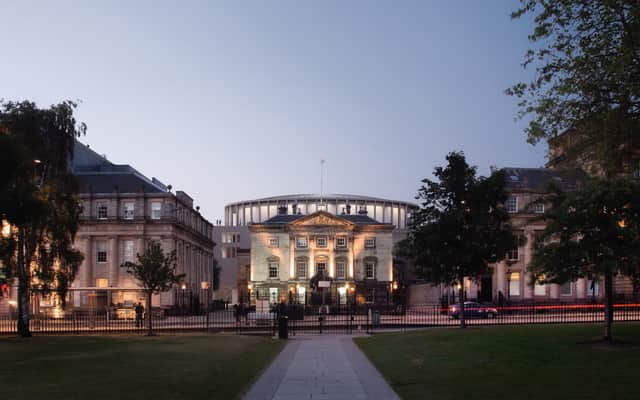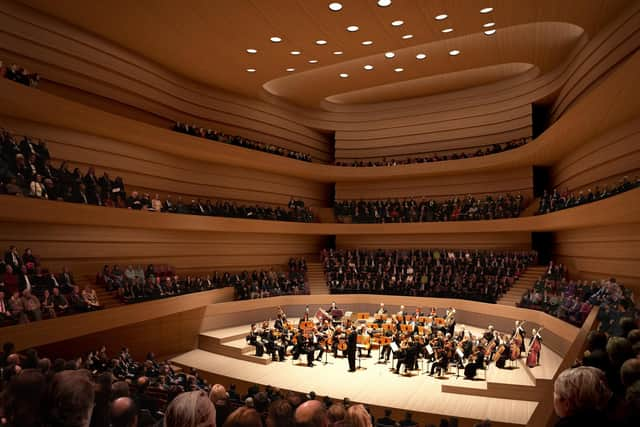First new concert hall in Edinburgh for a century scaled back after legal wrangle


The capacity of the main auditorium has been cut back and a second performance space dropped from the troubled development, which is earmarked for a site in the New Town.
Backers of the venue, which would be built off St Andrew Square, have admitted they will “regrettably have to lose” several key aspects of the building when new designs are revealed next year, adding that they are having to be drawn up within a “new set of parameters”.
Advertisement
Hide AdAdvertisement
Hide AdInsiders say the concert hall’s capacity could be cut from 1,000 to as low as 850 in order to meet demands from a neighbouring developer to reduce the building’s height.


Other elements previously announced, which are no longer on the project’s official website, include an all-day cafe-bar, and rooms for educational workshops, rehearsals and recordings.
The venue, which is planned to be a major new venue for use during the Edinburgh International Festival and a permanent home for the Scottish Chamber Orchestra, is now not due to open until 2025 – four years later than originally envisaged.
The scaling back of the concert hall has emerged weeks after it was revealed that Sir Ewan Brown, the figurehead of the project, had stepped down.
Advertisement
Hide AdAdvertisement
Hide AdThe latest problems are a major setback for the venue, which had £25 million worth of support from the Scottish and UK governments and the city council, and is expected to cost at least £75m.
Architects and designers working on the project for the Impact Scotland trust were forced to return to the drawing board in January after the charitable trust pursuing the project agreed to redesign the venue to resolve a dispute with the real estate firm behind the St James development.
It claimed that views from its luxury hotel would be blocked by the concert hall, which is being designed by award-winning British architect Sir David Chipperfield.
Councillors approved his vision in April 2019 – three years after the venue was announced.
Advertisement
Hide AdAdvertisement
Hide AdHowever it ran into trouble last summer when it emerged that Nuveen Real Estate was seeking a judicial review. Nuveen only agreed to drop the legal challenge on the basis that the concert hall was “substantially reduced.”
Last summer it emerged that Carol Grigor, the American arts philanthropist bankrolling the project, had upped her contribution to £35m.
A £15m fundraising campaign has been running over the last year, but the new projected cost is not expected to be known until 2021.
A spokeswoman for Impact Scotland said: “Creating a world-class concert hall with the very best acoustics and audience experience, in a location accessible to all, continue to be the goals of this project.
Advertisement
Hide AdAdvertisement
Hide Ad“The design is currently at a very early stage and we look forward to consulting stakeholders as it develops and publicising it in advance of going to planning early next year.
“We are still considering several design iterations, all of which keep the hall’s maximum capacity as close to 1,000 as is possible.
“To do this and meet the requirement to reduce the size of the whole building as agreed in mediation, means we will regrettably have to lose other aspects of the building, principally the studio.
“Ultimately, we believe we can still fulfil our core objective of making a major contribution to the future of music in Scotland, within the new set of parameters.”
A message from the Editor:
Advertisement
Hide AdAdvertisement
Hide AdThank you for reading this story on our website. While I have your attention, I also have an important request to make of you.
The dramatic events of 2020 are having a major impact on many of our advertisers - and consequently the revenue we receive. We are now more reliant than ever on you taking out a digital subscription to support our journalism.
Subscribe to scotsman.com and enjoy unlimited access to Scottish news and information online and on our app. Visit www.scotsman.com/subscriptions now to sign up.
By supporting us, we are able to support you in providing trusted, fact-checked content for this website.
Joy Yates
Editorial Director
Comment Guidelines
National World encourages reader discussion on our stories. User feedback, insights and back-and-forth exchanges add a rich layer of context to reporting. Please review our Community Guidelines before commenting.